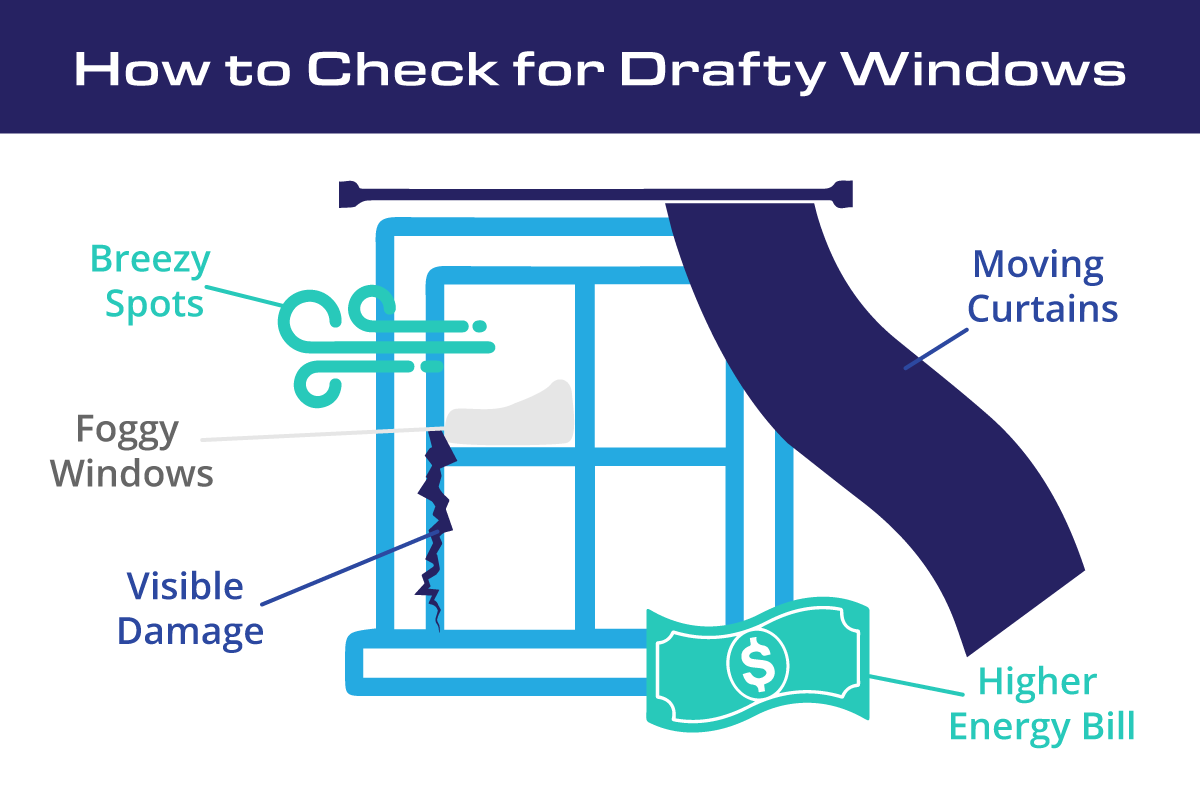Have you noticed your heating bill going up but no changes to the temperature in your home? Or do you feel occasional cold spots by your windows? This probably means you have a draft.
But how do you know if you have drafty windows? Windows leaking cold air can sometimes be hard to notice, especially if you don’t know what to look for. Fortunately, there are multiple things you can look for to find out if you have a draft.
In this blog, we’ll go over five ways to check for drafty windows and simple steps you can take to repair them.
1. Check for Breezy Spots
If you notice a breeze or cold spots when you walk by a closed window, it’s a clear sign you have a draft. To make sure this is the case, hold your hand around the edge of the window and feel for cold spots.
If you’re still not sure, you can try the candle trick to see if your windows are drafty. To do this, hold a lit candle close to your window on a windy day and watch the flame. If the flame bends, it means that air is coming in through the windows from outside.
2. Watch for Foggy Windows
If you find that certain windows are always foggy in the morning after a cold night, there’s probably a draft. The fog comes from condensation and moisture building up on your window. It means that moist air is coming from outside and into your home. This moisture usually gets in through a broken or weak seal between the panes of glass.
However, not all foggy windows are worrisome. You may have noticed foggy windows after showering or cooking. A good rule of thumb is that if the condensation quickly goes away, it’s not something you should be concerned about. It’s only when the condensation stays for a long time that you need to consider repairs or replacement.
Foggy windows are also a sign of high moisture, which may warp window frames made of aluminum, wood or vinyl. This excessive moisture can also seep into the seal and cause mold and mildew growth. Mold and mildew eat away at rubber seals and weatherstripping over time, causing more drafty gaps.
3. Look for Visible Damage
There are a few different types of visible damage to watch for, including cracks in the caulk or glaze, old windows and poor installation. We will discuss each of these types in more detail below.
Cracks in Window Caulk or Glaze
Window caulk and glaze naturally wear down over time. But they are especially vulnerable in areas like Northern Illinois and Southern Wisconsin, where the weather changes frequently and there is often high humidity.
You will want to check and replace your window caulk at least once a year. This is to ensure the window is sealed properly and stays in place. If you see that it looks really dry or has cracks, it’s time to replace it.
On the other hand, you only need to replace window glaze periodically. You’ll know if you need to do this if your windowpanes feel loose or rattle when tapped.
Old Windows
Older windows were usually made with wood frames, which can crack and warp throughout the seasons and cause gaps in your windows. These frames have a hard time withstanding harsh Midwest winters.
Old windows also aren’t energy-efficient and become drafty much sooner compared to windows made with vinyl.
So, if you know your windows are older, make sure to check for cracks or warping within the frame. Watch for these different kinds of warping:
- Bow: Bends along the face of the window
- Crook: Frame bends on the edge of the window
- Cup: Frame curls inward or outward
Warped windows can also be very difficult to open. So, if you notice warping or are having trouble opening your windows, it’s probably time to replace them rather than repair them.
Poor Installation
Look to see if your windows have been installed properly. If not, that’s what might be causing your drafty windows.
Signs of poor installation include:
- Gaps between the window and the frame
- Windowpanes that are the wrong size
- Weak seals around the outside of the frame
- Messy or sloppy caulking
- Difficulty opening or closing windows
Fortunately, a professional contractor can easily fix your poorly installed windows. We do it all the time here at Renowned Building Solutions and would be happy to help you too!
4. Keep an Eye Out for Moving Curtains
Take note of your curtains or blinds moving when your windows are closed, especially on a breezy day. If that happens, it likely means there’s a sizable gap creating a draft in your windows.
To double-check, close any nearby vents and turn off any fans that are by your curtains or blinds. If they no longer move after doing that, your windows are probably okay. If they continue to move, you have a draft.
5. Review Your Energy Bill
You’ll also want to keep an eye on your energy bill as you enter the colder months. A drastic increase in how much you’re paying could mean your home is using more energy on heating because the heat is going right out the window!
When your heating system works overtime like this, it can lead to higher-than-average wear and tear and expensive repair bills. So, it’s best to fix your drafty windows quickly before they wind up costing you more money!
 How To Fix Drafty Windows
How To Fix Drafty Windows
Now that you know how to check for drafty windows, how do you fix them? Fortunately, there are some easy steps you can take to repair drafts and avoid cold air leaking through windows. These steps include:
- Locking your windows
- Applying weatherstripping
- Updating your window caulk
- Reglazing your windowpanes
- Layering your curtains
- Repairing or replacing your windows
We’ll take a closer look at each of these below.
Lock Your Windows
Locking your windows is one of the first and easiest things you should do to avoid window air leaks. This step helps to keep small gaps closed and firmly sealed in your window. This is because the locks pull your window sashes together, closing the spaces where air can leak through.
Apply Weatherstripping
Weatherstripping your windows is relatively easy; it just takes some time and tools to get the job done correctly. This step is essential for closing off air leaks in your windows.
When buying weatherstripping, you’ll want to make sure to get the right type for your window. Some types of weatherstripping include foam tape, felt, or what’s called a V-channel or tension seal. Double-hung windows need both foam tape and tension seal weatherstripping. However, casement windows only need foam tape.
Here are a few steps to follow when applying weatherstripping:
- Before applying, open the window and clean everything with soapy water.
- Make sure to cut the weatherstripping to the length of your window.
- Apply the weatherstripping based on which type of window you’re using.
For additional steps and information, Lowe’s provides a helpful guide on its website.
Update Your Window Caulk
Another easy way to repair drafts is to apply new caulk to your windows. Before you start, you will need to get a caulking gun and high-quality caulk. Then follow these simple steps:
- Remove any old caulk from your windows.
- Use a caulking gun to apply caulk around the perimeter of your window on the inside and outside.
- Let the caulking dry, and you’re done!
We recommend you do this step at least once a year to ensure you don’t have windows leaking cold air.
Reglaze Windowpanes
If while checking for drafts you noticed your windowpanes are loose, then you’ll want to reglaze them as soon as possible. Fortunately, this task is just as simple as caulking your windows. Just follow the following steps:
- Remove all old glazing.
- Clean the windows.
- Apply glaze either with a putty knife or a caulking gun (a putty knife is better for smaller windows).
Once you’ve applied the glaze, your windowpanes should be good to go!
Layer Your Curtains
You might not know it, but blinds and curtains do more than keep the sun out of your eyes. They also help with insulating your home. This is because layering your curtains helps keep the cold air locked in between the fabric and windows.
So, if you already have curtains and blinds on all your windows, consider getting thermal curtains or blinds. These kinds are thicker and further help to keep the cold trapped behind the fabric.
Update and Replace Your Windows
The best way to prevent drafty windows is to update to higher-quality ones! There aren’t many drafty windows that don’t have some type of damage to them. And it’s better to have windows built to last through bitter Midwest winters and humid summers.
In the long run, replacing windows will save you more money because your heat will stay in the house. Plus, they’ll save you time because you won’t have to repair your windows each season!

Don’t let your hard-earned money fly out drafty windows. Repair them today!
Ditch Drafty Windows for Good
Drafty windows are no joke when it comes to taking care of your home. By following these steps, you’ll identify leaks and fix them to save money and keep your home warm.
While you can do this on your own, it never hurts to hire a professional to fix your problem windows. We at Renowned Building Solutions would be happy to help! So, if you notice air leaks, foggy windows or deteriorating frames, please call 844-736-6961 for a free quote.

